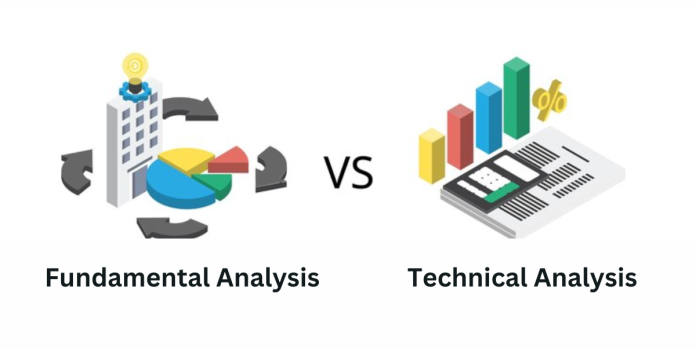Fundamental analysis and technical analysis are two of the most popular methods for analysing investments. Fundamental analysis looks at the underlying fundamentals of a company, such as its financial statements, management, and products, to determine its intrinsic value. Technical analysis, on the other hand, looks at the price movements of a security over time to identify patterns and trends that can be used to predict future price movements.
In this article, we will discuss the differences between fundamental analysis and technical analysis, and how to use them to make better investment decisions. We will also discuss some of the pros and cons of each method, and how to combine them for the best results.
Fundamental Analysis: The Long-Term approach to investing
Fundamental analysis is a method of evaluating a security by looking at its underlying fundamentals, such as the company’s financial statements, management, products, and competitive landscape. The goal of fundamental analysis is to determine the intrinsic value of a security, which is the fair price that the security should be trading at.
Fundamental analysts use a variety of factors to assess a security’s intrinsic value, including:
Financial statements: Fundamental analysts examine a company’s financial statements to get a sense of its financial health. They look at things like the company’s revenue, earnings, debt, and cash flow.
Management: Fundamental analysts also assess the management team of a company. They look for things like the team’s experience, track record, and vision for the company.
Products and services: Fundamental analysts also consider the company’s products and services. They look at things like the demand for the products or services, the competitive landscape, and the company’s ability to innovate.
Industry trends: Fundamental analysts also consider the industry in which the company operates. They look at things like the industry’s growth prospects, the level of competition, and the regulatory environment.
Read: How to Start Investing in the Stock Market
Once a fundamental analyst has assessed all of these factors, they can then make an informed judgment about the intrinsic value of the security. If the security is trading below its intrinsic value, the fundamental analyst may recommend buying it. If the security is trading above its intrinsic value, the fundamental analyst may recommend selling it.
Technical Analysis: The Short-Term approach to investing
Technical analysis is a method of evaluating a security by looking at its price movements over time. Technical analysts believe that past price movements can be used to predict future price movements.
Technical analysts use a variety of tools to analyse price movements, including:
Chart patterns: Technical analysts look for patterns in a security’s price movements. These patterns can be used to identify potential support and resistance levels, as well as potential trend reversals.
Moving averages: Moving averages are a type of technical indicator that smooths out the price movements of a security. Moving averages can be used to identify trends and to identify potential entry and exit points for trades.
Indicators: There are many other technical indicators that technical analysts use. These indicators can be used to measure things like momentum, volatility, and volume.
Technical analysts believe that by analysing price movements and other technical indicators, they can identify patterns that can be used to predict future price movements. However, technical analysis is not a perfect science, and there is no guarantee that it will be successful.
Read: Mastering the Art of Intraday Trading
Which is Better?
Fundamental analysis and technical analysis are both valuable tools for investors. However, they have different strengths and weaknesses. Fundamental analysis is better for investors who are looking to make long-term investments, while technical analysis is better for investors who are looking to make short-term trades.
Ultimately, the best way to choose between fundamental analysis and technical analysis is to consider your own investment goals and risk tolerance. If you are a long-term investor, then fundamental analysis is a better choice. If you are a short-term trader, then technical analysis is a better choice.
Conclusion
Technical and fundamental research are both crucial tools for investors. You can make better financial judgments if you are familiar with both of these techniques.
Here are some additional tips for using fundamental analysis and technical analysis:
Use both fundamental analysis and technical analysis. No single method is perfect, so it is important to use both to get a more complete picture of security.
Be patient. It takes time to learn how to use fundamental analysis and technical analysis effectively. Don’t expect to become an expert overnight.
Practice on a demo account before you start trading with real money. This will help you to get a feel for how the markets work and to test out your trading strategies.


